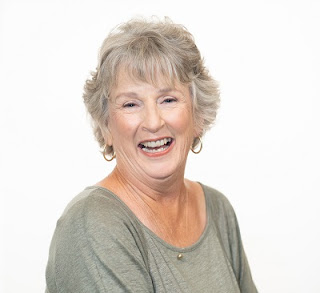I have been performing since I was 7 years old, playing Gretel in a musical version of the fairy tale. I know
the safest place on the planet is a stage, because the audience is waiting for you to be wonderful. I
know that leaping from the local arena to the national arena is a huge leap, and that opportunity comes
rarely, if ever. When I was directing shows on a regular basis, I wanted to make the leap from the local
theatre community to regional theatre. Couldn’t figure it out. Couldn’t find the opening, which I found to be frustrating and disappointing.
When I shifted from theatre as my creative outlet and expression to storytelling, I was content to be a
large fish in a very small pond. I was content to teach storytelling and facilitate workshops because of the difference it made to the participants. And then I entered Act III of my life.
I am 69 years old. If not now, then when, Beth?
I finished my Master’s degree in storytelling when I was 61 years old, in 2011. To celebrate that
milestone, Mylinda Butterworth and I traveled to Utah to the Timpanogas Storytelling Festival. I had
never been west of the Mississippi River. I was mesmerized by the enormity of the mountains and the
vastness of the landscape. We challenged our bodies (that live at sea level) to climb the mountains to
the Timpanogas Caves. And then we went to the Timpanogas Storytelling Festival.
Mylinda and I had just completed a 5 day intensive workshop with Antonio Rocha and Milbre Burch at
ETSU, and both were performing at Timpanogas. We felt privileged to know some of the tellers
personally. loved every minute of the festival. We laughed until we cried, and cried until we laughed.
And we said to each other, “Someday, I will tell at this Festival.”
For several years, I had visited the Timpanogas Storytelling website, and thought about applying. And
then that little voice inside said, “If not now, then when?” The audition process included having a
professionally recorded story – either audio or video. I had made the Distilling Hope CD in 2017, and finally had that professionally recorded piece. I applied.
I was accepted.
I was one of 2 tellers chosen for the TimpTells Teller slots. When I received the letter inviting me to
come as a teller, I had to give the letter to my beloved to read…just to make sure I was reading the black parts on the page…not what I wanted to read. It was real.
“I am not giving away my shot!” which is the opening line from ‘Hamilton” became my mantra. I had
this one shot on a national stage. It was an honor and a privilege to be there. I wanted to give it my best shot. So I asked for help.
Asking for help is not my strong suit. I did it anyway. In a workshops at the National Storytelling Summit,
I had discovered 2 personal stories. I asked Andy if they were worthy of the Timpanogas stage. “Oh
yeah!” was his reply. I asked Donald Davis for his advice. He said, “Tell original stuff. That will make you
stand out.” Donald also encouraged me to have 4 stories prepared just in case one that I planned
wouldn’t work following another teller. I arranged for Andy to coach me. In a weekend intensive, I
road tested those stories. We realized that one of those stories would work, and one would not. I had
to find another story. I searched my repertoire for another original story that I knew like the back of my
hand. I agonized over that choice. Finally I settled on a ghost story I had created for Furnace Town, a
living history museum, and a Scottish legend. I prepared all 3 and worked hard. I had a dress rehearsal
at my home with 15 friends. I called another storyteller shared my stories, and got feedback.
We flew to Utah for the festival. I was giddy with excitement. Finally, I stepped onto the stage, and I
was home. I remembered the feeling of being onstage and giving my best to an audience so that they
may be temporarily suspended in time, transported to another realm, and dancing with me as audiences
do. For the first time in a long time, I trusted my preparation and my talent to make the experience memorable. I succeeded.
Back at home, the Timpanogas Storytelling Festival seems like a dream, a fairy tale, a silver box
experience. The memory is stored in the silver box in my heart. The coach has turned back into a pumpkin. The dream recorded on this page.
Many thanks to everyone who made this dream come true.



